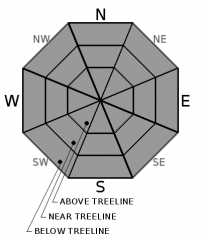| Saturday | Saturday Night | Sunday | |
|---|---|---|---|
| Weather: | Sunny. Snow levels below 7000 feet increasing to 7000 feet in the afternoon. Chance of precipitation is 0%. | Mostly cloudy then becoming clear. Snow levels below 7000 feet. Chance of precipitation is 0%. | Partly cloudy then becoming sunny. Snow levels below 7000 feet. Chance of precipitation is 5%. |
| Temperatures: | 43 to 48 deg. F. | 26 to 32 deg. F. | 38 to 43 deg. F. |
| Mid Slope Winds: | Light winds. | Light winds becoming southwest around 15 mph after midnight. Gusts up to 30 mph. | Light winds. Gusts up to 30 mph in the morning. |
| Expected snowfall: | No accumulation. | SWE = none. | No accumulation. | SWE = none. | No accumulation. | SWE = none. |
| Saturday | Saturday Night | Sunday | |
|---|---|---|---|
| Weather: | Sunny. Snow levels below 7000 feet increasing to 7000 feet in the afternoon. Chance of precipitation is 0%. | Mostly cloudy then becoming clear. Snow levels below 7000 feet. Chance of precipitation is 0%. | Partly cloudy. Snow levels below 7000 feet. Chance of precipitation is 5%. |
| Temperatures: | 39 to 45 deg. F. | 25 to 30 deg. F. | 34 to 40 deg. F. |
| Ridge Top Winds: | Light winds becoming southwest around 15 mph in the afternoon. | Southwest around 15 mph increasing to 20 to 30 mph after midnight. Gusts up to 55 mph. | Southwest 15 to 20 mph with gusts to 50 mph in the morning becoming light. |
| Expected snowfall: | No accumulation. | SWE = none. | No accumulation. | SWE = none. | No accumulation. | SWE = none. |


















